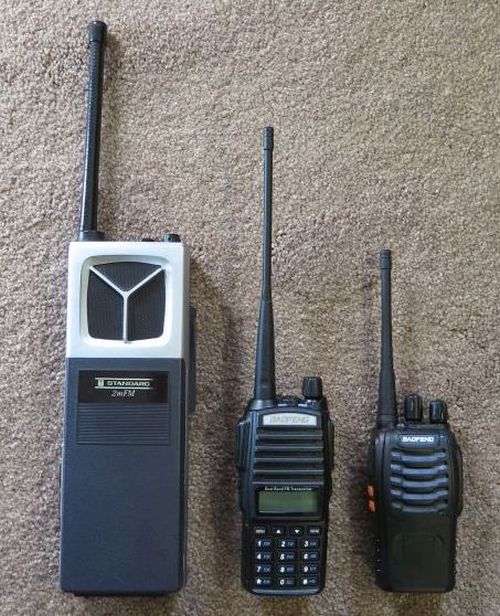Review: The Impossible Baofeng HTs

I bought my first ham radio handheld ("handied-talkie" or HT) back in 1977. The Standard Radio SR-C146 had five crystal-controlled channels and weighed two pounds. (No wonder they called it a "brick.") No TT pad, no CTCSS. I don't recall what I paid for it new, but I'm thinking $350--and that didn't even include a charger. (I built a charger for it from scratch!) That would be about $1400 today. It was a really big deal, and I used it for almost ten years, until I bought an Icom HT at Dayton in 1986.
In truth, I never used HTs all that much except at hamfests. I've had 2M mobiles in various cars, and for the past 18 years or so have used an Alinco mobile rig as a base. I still have the Icom in a box somewhere, but the case is cracked and it's been in the corner of my mind to get a new HT for almost ten years.
Then Bob Fegert mentioned the Baofeng dual-band UV-82 HT, which now sells on Amazon for $37 brand new. (I actually paid $35.) In 1977 dollars, that would have been...ten bucks. So I ordered one. While cruising the Web looking at reviews and commentary on the unit, I happened upon the Baofeng BF-888S. Amazon had those for $15. $3.85 in 1977 funds. So I bought one of those as well, just to see what a $15 HT could do.
Both radios put out 1W or 4W selectable. The UV-82 covers the 2M and 70cm bands. The BF-888S covers only the 70cm band. Well, actually not only the ham bands, which is an issue worth a little discussion here. Many commenters on the ham boards loathe these radios, for a simple reason: They claim the ham radio positioning is only a ruse, to get around FCC type acceptance.
The problem is that for use on the several business bands, the Family Radio Service (FRS), the General Mobile Radio Service (GMRS) and the Multi-Use Radio Service (MURS), a transceiver must meet certain FCC requirements and pass tests to ensure that it meets those requirements. This is called type acceptance. A type-accepted radio will transmit only where its type acceptance allows. There are other requirements that aren't about frequency. FRS radios, for example, may not have removable antennas. Ham radio gear, on the other hand, does not require FCC type acceptance at all.
These are software-defined radios. Within a broad band of frequencies dictated by the output power amp, they can receive or transmit anywhere you want them to. A free program called CHIRP allows you to create a special-purpose database of frequencies and other settings, save it as a file, and then squirt it into the radio through a USB cable. It's nominally illegal to use a radio like the BF-888S on FRS or GMRS, but a quick Web scan shows that it's evidently done quite a bit. The type acceptance process takes time and money, so a radio pitched for amateur use can cost less.
The flexibility of using CHIRP to set frequencies and settings allows these radios to also act as scanners and receive public safety and weather channels. It's possible to disable transmit on any frequency, which I did for the weather channels. (One of the downsides of the display-less BF-888S is that it's not always obvious what frequency you're tuned to. Mistakes are possible, and in this case may be rule violations that may cause interference.)
As 2M and 70cm radios, they're pretty good. I can hit all the repeaters I usually reach from here, just using the "rubber duckie" antennas. Audio is clean and strong. The UV-82 has a better receiver: Weak local signals will break squelch on the UV-82 when they won't budge the BF-888S.
There are some downsides:
- Neither radio has a squelch knob. Squelch levels are parameters that you set from the keypad (for the UV-82) or in CHIRP. This can be annoying if your noise level rises and falls for some reason, or if a weak signal is right on the edge of squelch. (The BF-888S has a button that turns squelch off while pressed, which is better than nothing.)
- The chargers are flimsy and almost weightless. I'm not sanguine about how long they'll last, and they certainly aren't physically stable. Nor are the chargers or charge voltages the same for the two radios.
- The antenna connectors are SMAs. I had to order some SMT-UHF adapters so that I could use my discone antenna up in the attic.
- Both radios "speak" a channel number when you move up or down the channel set. With the BF-888S this is the only reliable way to know where you're sitting, as the numbers on the channel select knob are almost invisible.
- The UV-82 has a broadcast FM radio feature, which works fairly well but is not easy to use, especially if you switch stations a lot. (It is a little weird hearing classical music coming out of a ham radio HT.)
- Although it would be very useful, I don't think it's possible to control (rather than simply program) either radio through the USB cable.
Both radios have white LED flashlights built-in, for what it's worth.
So. I'm sure a Yaesu or an Icom HT would be better in a great many ways. However, Icom HTs don't cost $35. Given how little I use HTs, the price was irresistable. How well they will serve over time is an open question. They seem rugged enough to withstand a certain amount of outdoor rough-and-tumble. If they break (or if anything weird happens) I'll certainly tell you here.
So far, recommended.